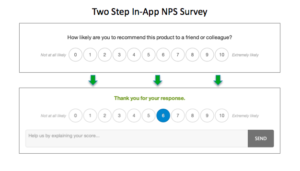Is NPS a percentage?
The NPS is not really a percentage. It is subtraction of two percentages: percentage of promoters minus percentage of detractors. It’s an index ranges from negative one hundred (-100) to one hundred (+100).
NPS calculation example
Let’s say 30% of your customers report they are likely to recommend your company, while 5% would not recommend you to their peers, your Net Promoter Score would then be: 30-5= 25
Notice that Promoters and Detractors in the Net Promoter System have a very precise definition.
A promoter is a survey respondent who gives a rating of 9 or 10 to the NPS survey question: On a scale of 0 (not at all likely) to 10 (extremely likely), how likely would you recommend our product/service to a friend or coworker?
A detractor is a survey respondent who gives a rating of 0 to 6 to the NPS survey question: On a scale of 0 (not at all likely) to 10 (extremely likely), how likely would you recommend our product/service to a friend or coworker?

A survey respondent answering the NPS survey question with a 7 or 8 is considered ‘neutral’ and won’t count towards either the detractor % or the promoter %. If every survey respondents were to rate their willingness to recommend as a 7 or 8, then the Net Promoter Score would be zero: 0-0=0.
Therefore, the NPS calculation is simple: % Promoters – % Detractors, and the survey itself is short and sweet: a single question: “On a scale of 0 (not at all likely) to 10 (extremely likely), how likely are you to recommend our product/service to a friend or coworker?”
As with any survey, the complexity is in the surveying: whom do you survey, how do you survey, where, when do you survey, how often do you survey, what do you survey?

See ROI in Half the Time
Pearl-Plaza’s integrated CX approach increases customer lifetime value and bottom line performance in just 12 months, significantly faster than the industry average of 25 months!



